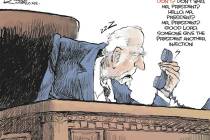We pry because the dead can’t speak for themselves
The day after the coroner announced that the death of impressionist/singer Danny Gans was accidental, the Review-Journal received a reply to our public records request for Gans' toxicology report.
Denied. No surprise.
The letter cited precisely the document we expected, a 1982 opinion from then-Attorney General Dick Bryan, who later served as governor and U.S. senator and has since retired to private practice.
The letter explained, "The opinion, rendered on June 15, 1982 states that autopsy reports are not open to the public for inspection, copying or dissemination. The reasoning is because the reports contain confidential medical information about the decedent that should not be open to the public."
Yes, we are fully familiar to the Bryan extra-legal concept fashioned out of vagaries and sleight of hand.
In a bizarre conclusion to his opinion, Bryan opines that autopsy records are in fact public records, which state law declares to be open to public inspection unless otherwise declared closed by law, but then declares them private.
"An autopsy protocol is a public record," the opinion states, "but is not open to public inspection upon demand, because disclosure would be contrary to a strong public policy ... maintaining the confidentiality of the medical information contained in the protocol accords with the intent of the governing ordinances and the administrative interpretation thereof."
In the opinion, Bryan finds that the medical records of living persons are widely construed to be private and personal, and then makes the leap that the privacy is carried to the grave.
The living have a right to defend themselves against defamation, but the courts have declared the dead have no such rights. The living can speak for themselves. No one can speak for the dead.
Nothing against the coroner's conclusion in the Gans case, but if the toxicology report were allowed to be inspected by an independent medical examiner, might not another opinion be found?
Further unanswered questions were raised in Friday's Review-Journal story by Paul Harasim, who quoted a doctor who had treated Gans, saying Gans had no current prescription for the drug said to have contributed to his death.
The public should demand public scrutiny, not for some celebrity-gawking, scandal-mongering reason, but because that is the only way to assure justice is served. That is why we have public trials and open records. We trust our public officials, but require verification.
Now the case is closed. No one, so far as we will ever know, will be found culpable or contributory.
Gans can't speak for himself. Who will?
-- -- --
On Friday a week ago, I scanned a proof of the back page of our Sunday Viewpoints section, where we publish a half-dozen or so editorial cartoons. None seemed all that outrageous.
The next day an Associated Press story said some were upset with a cartoon by Chip Bok, which was to be published Sunday. I read the comments, and decided to let it stand.
The cartoon depicted Supreme Court nominee Sonia Sotomayor as a piñata and President Barack Obama in a sombrero asking a group of elephants, "Now, who wants to be first?"
AP quoted Rossana Rosado, publisher and chief executive officer of El Diario La Prensa in New York, saying, "On first view you just see her hanging by a rope and that's a very disturbing image. It's offensive mostly because it's not funny. It's supposed to be satirical and humorous and it simply isn't funny."
Not funny? Since when is that a criteria?
After the Review-Journal published the Bok cartoon I got a grand total of one complaint: "I was saddened to see that your paper chose to include in its cartoon section the Chip Bok cartoon, it is both tasteless and demeaning to the nominee Judge Sotomayor and our president. It was a self-indulgent exercise in stereotyping ... I would hope we might at some point get beyond this distasteful stuff."
I shared her comment with Jim Day, our resident cartoonist, philosopher and student of the history of visual commentary, who offered, "An assay of the typical political cartoon would show the presence of irreverent humor as well as elements of meanness, spitefulness, prejudice, tastelessness as well as a tinge of old fashioned patriotism -- and the truth. ...
"When ... we arrive at a point when we are 'beyond this distasteful stuff,' it will only be because all political cartoonists and columnists have been rounded up and sent off to a re-education camp."
Careful, Jim, I think I hear the pounding of hammers. I don't think they are building a re-education camp.
Thomas Mitchell is editor of the Review-Journal and writes about the role of the press. He may be contacted at 383-0261 or via e-mail at tmitchell@ reviewjournal.com. Read his blog at lvrj.com/blogs/mitchell.























